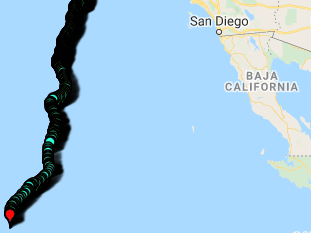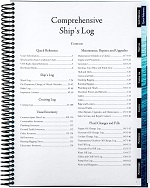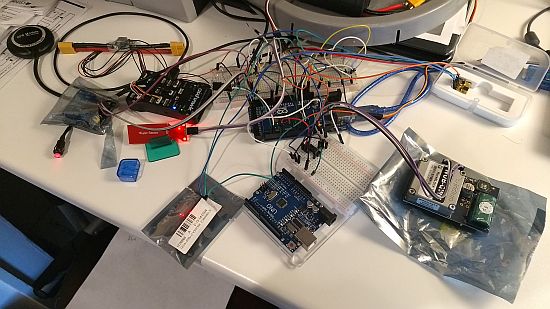Launch in 2, 1…
In two days (weather permitting), LoCARB will be launched from Half Moon Bay, Ca. I started the build February 2019 and its taken me a year and 5 months to get it to ready for launch. To be honest, i’m a little anxious thinking about it, going through my pre-launch checklist to make sure I have everything covered and confirmed working. One thing I don’t want is to launch and then suddenly realize I forgot to do something with the boat going willy-nilly in the ocean.
LoCARB getting a paint job
Where i’m at
Its a little strange being at this point honestly, I thought I would wait till next year to coincide with the longer daylight hours but after some risk analysis, I figure I should just do it and not have to redo the inevitable dead battery (what a pain)! As well, if the boat does get to Hawaii in 40-60 days, it will coincide with the summer days in Australia, which would be its next stop. The boat build has really taken up a lot of time and energy this past year, it was filled with long periods of learning (and doubt) about how to go about doing one thing or another then tinged with brief splashes of success. And although pretty gratifying when seeing things come together its been tiring. I actually don’t want to think about this boat at all anymore, I just want to enjoy it by watching it sail across the Pacific ocean (but even then, it’ll be stressful!).
What do you think the chances are that it will get to Hawaii?
People ask me what chance I think LoCARB has with getting to Hawaii. I tell them 10%, i’m not kidding. The ocean is a treacherous place. Endless amounts of salt water, storms, wind, waves, heat. Its just a hostile environment for something so fragile as a home made, DIY on the cheap solar powered boat with consumer grade RC components. I mean, c’mon the boat is using a $2 composite propeller I got off ebay (even though I did test it for 8 months soaking in ocean water, and still found it surprisingly stiff and serviceable). Nothing about this boat inspires confidence in me, except that I know it wont sink (its inner cavity is closed cell foam so it’ll just drift to oblivion). From the ebay no-name micro-controller to the cheap wiring used, it just doesn’t give me the feel-goods that it can make the trip. Ive taken some precautions by hot gluing the wires to keep them from vibrating (and thus breaking off at the solder joints), and slapping some extra epoxy on areas which may spring leaks. But that’s about it.
Why the Stripes?
 Research suggests sharks may not want to tangle with a sea snake…Also, the stripes should keep the boat from looking too much like a seal for a shark to think its food (that’s the hope anyway).
Research suggests sharks may not want to tangle with a sea snake…Also, the stripes should keep the boat from looking too much like a seal for a shark to think its food (that’s the hope anyway).
Did you stay within your budget?
No. I was close, but I wasn’t able to make it within the $1500 budget I had set in mind to keep. In total, I spent $1911.53. The items pushing me out of budget were the Machining of the waterproof barrier, the boat paint, the genuine GPS module to replace the counterfeit module, and more fiber-glassing materials to redo the motor pod when the first car battery went dead.
Final software tweaks for launch
What lessons did you learn in the process?
Gosh, I learned a TON from this project. In fact, after working with LoCARB, building the shed in my backyard was a breeze. Every other project I’ve done till now has paled in comparison to what it took to plan, build, and execute the LoCARB autonomous boat project.
Some notable stressors (in no particular order):
- Having to figure out how everything goes together before actually having the parts. Even more so when the parts don’t exist and you have to make them.
- Realizing specific documentation for a solution to a problem you’re experiencing doesn’t exist, and you have to come up with it on your own (like creating a messaging protocol, or reverse engineering a library with no documentation to update way-points on a Pixhawk using the Mavlink protocol).
- Learning a programming language or two, or three, and making them all work together.
- Anticipating future problems in a field where you are too inexperienced (like working with incompatible materials).
- Trying to explain why you want to send a boat to Hawaii and not sound ridiculous (haha!).
Some Highlights (in no particular order):
- Realizing there are people in the world who will see what you are trying to accomplish, come alongside, and enthusiastically help you!
- Solving a really difficult problem on your own.
- Learning new skills.
- When you tell another person what you’re building and they’re genuinely interested.
- Finally completing a difficult project that’s taken over a year, even if it may not accomplish its final goal.
What are the checklist items you need to finish before launching?
There are just a few more things to do before launching which I wasn’t able to button up until closer to the launch date.
- Calibrate the current draw when the boat is moving in the water for more accurate status updates.
- Tighten and secure the solar panel bolts, cut off the extra threads, and seal with marine adhesive.
- Apply some decals and seal the brain box before launch.
Removing the RC testing components used for manual steering from the brain box.
How do you feel about the launch?
Honestly, i’m anxious, nervous, excited and grateful…and there’s a little bit of sadness mixed in with all that. I think with any project that requires so much emotional and physical investment there will be a sense of loss when it comes to an end. My wife said its my “baby,” and in a way it feels like it really is. I’ve seen this “baby” through from conception to being able to move about on its own and now its grown up enough to leave the protected confines of the lake and sent out into the unpredictable ocean. Will it fail? Will it succeed? I really don’t know. LoCARB isn’t perfect, and it’s not something I would say with any more confidence than 10% that it will reach Hawaii. But despite that, I consider this project a success as the reward is not in the final destination and was all about the journey.








fingers crossed!
curious to see the data when you’re on your way, specifically speed and consumption…